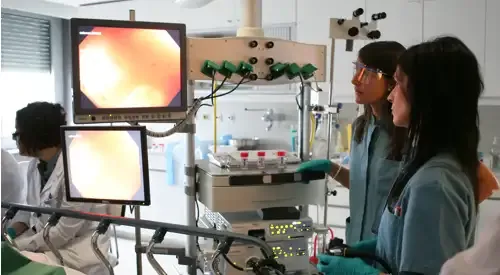Hemorrhoids
"Surgical treatment is the most effective and definitive solution to hemorrhoids".
DR. JORGE BAIXAULI
SPECIALIST. GENERAL AND DIGESTIVE SURGERY DEPARTMENT

In the distal section of the anal canal, the presence of structures in the form of "cushions" is normal, made up mainly of vascular tissue, called hemorrhoidal plexuses.
When, from the alteration of these structures a symptomatology is derived (bleeding, pain, exit to the exterior, etc.), one speaks of hemorrhoidal disease or hemorrhoids.
Hemorrhoidal pathology is multifactorial, that is, many causes can influence the development of hemorrhoids.
However, the most directly related to this pathology is constipation associated with frequent and constant straining.
Other possible causes of hemorrhoidal pathology are diarrhea (due to the chemical irritation of liquid feces on the hemorrhoids), the ingestion of certain foods (spicy, alcohol, etc.), pregnancy (caused by the pressure that the fetus exerts on the circulation of the venous return at the level of the pelvis), and even hereditary factors.

What are the symptoms of hemorrhoids?
The most common clinic that afflicts these patients is the bleeding, typically scarce and associated with the stool, accompanying the feces or in the cleaning maneuvers. However, at times it can be abundant and alarming.
Another frequent symptom is the outflow of a fleshy mass that corresponds to an internal hemorrhoid that comes out.
Pain is not a frequent symptom and when it appears it is associated with what is known as a hemorrhoidal crisis or with episodes of thrombosis of the hemorrhoids.
Other less important symptoms of hemorrhoids are: anal itching, mucus emission, etc.
What are the most common symptoms?
- Bleeding associated with bowel movements.
- Anal itching.
- Pain.
Do you have any of these symptoms?
You may suffer from hemorrhoids
How are hemorrhoids diagnosed?

The diagnosis of hemorrhoids or piles is based on the very characteristic symptomatology, followed by a physical examination in which a pathological dilation of the hemorrhoidal plexuses is evident.
The definition of the symptoms in hemorrhoids is of special importance, given that if the hemorrhoidal plexuses are normal structures, it is only when their alteration produces a clinical manifestation of some kind that we speak of hemorrhoidal disease.
However, given that other benign and malignant pathologies of the digestive tract may be present with the emission of blood through the anus, when this appears even with an evident diagnosis of hemorrhoids, it may be advisable to perform a colonoscopy to rule out other pathologies.
How are hemorrhoids treated?
The treatment of hemorrhoidal pathology will depend on the intensity of the symptoms that are presented.
Application of topical treatments by means of creams, ointments, suppositories, etc. These compounds usually present an association of local anaesthetics, anti-inflammatory (corticoids etc.), venous decongestants, etc. Anti-haemorrhoidal creams should be used for a limited time (no more than 5-7 days, because they can cause more bleeding).
When the disease is more advanced, especially when the dilation of the hemorrhoids and prolapse to the outside is greater, intermediate treatments can be tried before surgery, such as sclerosing injections, infrared photocoagulation (IPC) or laser, electrocoagulation, cryosurgery or elastic banding.
These treatments are only carried out in the case of internal hemorrhoids and their degree of effectiveness depends on how advanced the disease is.
When all of the above fails to control the symptoms of the disease, a surgical hemorrhoidectomy is indicated, that is, the removal of the pathological plexuses by surgery.
It is advisable to adopt a series of hygienic-dietary measures such as:
- Avoiding constipation as much as possible through a diet rich in fiber (fruit, vegetables, bread, cereals, etc.).
- Increase the intake of liquids (from 2 to 3 liters a day).
- It is advisable to avoid episodes of diarrhoea if they occur frequently. Try to have one bowel movement a day.
- Avoid foods with excess of spices and the consumption of alcohol.
- Carry out some exercise daily.
- Avoid straining when having a bowel movement, so that the defecation should be as spontaneous as possible, reducing the time needed to complete it.
- If the hemorrhoids prolapse (come out of the anus), it is best to try to return them to their usual position by making a slight pressure with the finger.
- In case of suffering from hemorrhoids, it is convenient to avoid the trauma of these during the cleaning with paper, being preferable the use of warm water or wet wipes.
- It can be beneficial in incipient hemorrhoids to perform sitz baths with warm water for 10-15 minutes, two or three times a day.
Where do we treat them?
IN NAVARRE AND MADRID
The Department of General Surgery
of the Clínica Universidad de Navarra
The Department of General and Digestive Surgery is made up of specialists dedicated to the surgical treatment of endocrine, breast, gastrointestinal, hepatobiliary, pancreatic, colorectal and abdominal wall diseases, with special dedication to oncological surgery.
The application of laparoscopic surgery in the interventions reduces the hospital stay, the post-operative discomfort and shortens the patient's recovery.
We have a great experience in laparoscopic colorectal surgery, of the adrenal gland, liver and pancreas, as well as in obesity surgery.
Treatments we perform
- Colorectal surgery.
- Breast surgery.
- Surgery of the hemorrhoids.
- Pelvic floor surgery.
- Endocrine and obesity surgery.
- Esophageal and gastrointestinal surgery.
- Hepatobiliary and pancreatic surgery.
- Abdominal wall surgery.
- Liver transplant.

Why at the Clinica?
- Center of Excellence in Obesity Surgery by the International Federation for Bariatric Surgery.
- 90% survival rate in liver transplants.
- We are the private hospital with the largest technological equipment.

















